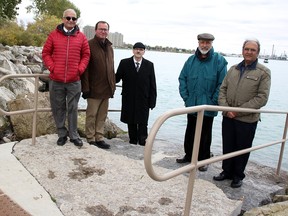When spreading a loved one’s ashes in a river or lake, it’s best to leave urns and other containers on dry land, experts say.

When spreading a loved one’s ashes in a river or lake, it’s best to leave urns and other containers on dry land, experts say.
Advertisement 2
Article content
Article content
Recommended Videos
Article content
Lambton OPP reported a blue and silver urn was found New Year’s Day washed up along the St. Clair River, south of Moore Line in St. Clair Township.
The urn wasn’t empty, Const. Jeanine Robertson said by email.
“We are unable to confirm the exact contents,” she said.
There were no markings indicating where the urn or its contents originated, Robertson said.
Police released details about the urn, along with a photo, asking anyone with information to call them at 1-888-310-1122.
Last January, Lambton OPP said an urn containing ashes was found on the shore of the river in Corunna.
The OPP will make every effort to find the owner of the urn found this month, Robertson said. Otherwise, it will be kept for one year and the OPP will “follow appropriate procedures according to local laws and policies,” she said.
Advertisement 3
Article content
“It is advisable to remove cremated remains from an urn or any container before scattering in a lake, river or stream,” said David Brazeau of the Bereavement Authority of Ontario.
“People will often remove such items from a lake when they come upon them,” Brazeau said. “Scattering prevents that.”
The authority is a non-profit corporation delegated to administer provisions of the Funeral, Burial and Cremation Services Act.
Brazeau said cremated remains can be legally scattered on Crown lands, including shores and beds of most lakes and rivers.
To confirm if an Ontario site is Crown land, visit ontario.ca/page/crown-land.
“The cremated remains must be scattered and not buried in a container such as an urn,” Brazeau said.
Advertisement 4
Article content
Cremated remains also can be scattered on private property, with the owner’s permission, he said. “We recommend getting such permission in writing.”
Federal lands, including national parks, some harbors and canal systems, are managed under federal law and sites under municipal jurisdiction may have restrictions on scattering cremated remains, he said.
Tom Wolfe, a funeral director at Sarnia’s DJ Robb Funeral Home, said they advise families planning to scatter remains that buying an urn isn’t necessary.
But he said there are water-soluble urns and containers available designed to dissipate when placed in a waterway, he said.
Wolfe said the funeral home where he works passes along information and advice to families who say they are planning to scatter remains.
Advertisement 5
Article content
“They come in a temporary container,” basically a zip-seal bag with a metal identification tag with the name of crematorium and a tracking number, he said
Several years ago, someone placed remains in such a temporary container in the river “and it was floating along,” Wolfe said.
That container ended up in the hands of city police, but the identification tag had been removed, he said.
Wolfe was involved several years ago with a group of local residents who raised money to create the Point Lands cremated remains scattering site along the river in Sarnia.

The project, funded by donations, opened in 2018.

Scattering cremated ashes in flowing water is a sacred ritual for followers of some faiths, including Sikhs and Hindus.
“It is widely used,” Wolfe said of the scattering site on the edge of the Point Lands, off Seaway Road.
Article content
